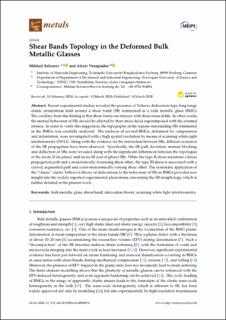| dc.contributor.author | Seleznev, Mikhail | |
| dc.contributor.author | Vinogradov, Alexey | |
| dc.date.accessioned | 2021-01-18T13:18:40Z | |
| dc.date.available | 2021-01-18T13:18:40Z | |
| dc.date.created | 2021-01-17T12:27:16Z | |
| dc.date.issued | 2020 | |
| dc.identifier.citation | Metals. 2020, 10 (3), 374-388. | en_US |
| dc.identifier.issn | 2075-4701 | |
| dc.identifier.uri | https://hdl.handle.net/11250/2723511 | |
| dc.description.abstract | Recent experimental studies revealed the presence of Volterra dislocation-type long-range elastic strain/stress field around a shear band (SB) terminated in a bulk metallic glass (BMG). The corollary from this finding is that shear bands can interact with these stress fields. In other words, the mutual behaviour of SBs should be affected by their stress fields superimposed with the external stresses. In order to verify this suggestion, the topography of the regions surrounding SBs terminated in the BMGs was carefully analysed. The surfaces of several BMGs, deformed by compression and indentation, were investigated with a high spatial resolution by means of scanning white-light interferometry (SWLI). Along with the evidence for the interaction between SBs, different scenarios of the SB propagation have been observed. Specifically, the SB path deviation, mutual blocking, and deflection of SBs were revealed along with the significant differences between the topologies of the mode II (in-plane) and mode III (out of plane) SBs. While the type II shear manifests a linear propagation path and a monotonically increasing shear offset, the type III shear is associated with a curved, segmented path and a non-monotonically varying shear offset. The systematic application of the “classic” elastic Volterra’s theory of dislocations to the behaviour of SBs in BMGs provides new insight into the widely reported experimental phenomena concerning the SB morphology, which is further detailed in the present work. | en_US |
| dc.language.iso | eng | en_US |
| dc.publisher | MDPI | en_US |
| dc.rights | Navngivelse 4.0 Internasjonal | * |
| dc.rights.uri | http://creativecommons.org/licenses/by/4.0/deed.no | * |
| dc.title | Shear Bands Topology in the Deformed Bulk Metallic Glasses | en_US |
| dc.type | Peer reviewed | en_US |
| dc.type | Journal article | en_US |
| dc.description.version | publishedVersion | en_US |
| dc.source.pagenumber | 374-388 | en_US |
| dc.source.volume | 10 | en_US |
| dc.source.journal | Metals | en_US |
| dc.source.issue | 3 | en_US |
| dc.identifier.doi | 10.3390/met10030374 | |
| dc.identifier.cristin | 1872637 | |
| dc.description.localcode | © 2020 by the authors. Licensee MDPI, Basel, Switzerland. This article is an open access article distributed under the terms and conditions of the Creative Commons Attribution (CC BY) license (http://creativecommons.org/licenses/by/4.0/) | en_US |
| cristin.ispublished | true | |
| cristin.fulltext | original | |
| cristin.qualitycode | 1 | |

